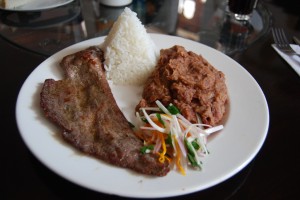Two New Restaurants and Traditional Cuzco Cuisine

Traditional Cuzco food has generally not been a big part of the offerings of restaurants in the tourist core of the city, though it is strong outside this core, where Cusqueños congregate. It is as if Cuzco were replaced with food from elsewhere, whether Lima or other countries. But recently two restaurants opened near the central Regocijo Plaza that claim to focus on Cuzco’s classic food, Chuwa and La Mila.
Though Cuzco has a rich and varied food history, it is a difficult task to offer traditional Cuzco cuisine. A restauranteur must go through a process of deciding what is typically Cuzco and what is not.
A couple of weeks ago I was at a celebration in a local home and the dish pachamanca came up. It is a dish of meat and other ingredients cooked in a pit on heated rocks and it is eaten across a wide range of the central and southern Andes. Knowing my interest in the food of Cuzco, the father of the family suggested we get together to make a pachamanca. His niece-in-law promptly spoke up to say, “But pachamanca is not from Cuzco. It is from Huánuco.”
In other words, people of Cuzco may make and eat pachamanca but the dish is defined, according to her, as belonging somewhere else.
This is the problem of so called “typical” food. It is food that besides being good is something that stands for someplace. It is supposed to carry something of the essence of a place.

In Cuzco, despite arguments of what is or is not typical, the cuisine has not been formally codified, other than as people talk and share with each other. For example, only one major cookbook has been put together celebrating Cuzco food, Rosario Olivas Weston’s Cusco: Imperio de la cocina and, though an award-winning and masterful explanation of Cuzco’s food and its cultural context, the book is much more available in Lima than in Cuzco.
As a result I went to both restaurants with a fair amount of curiosity.
Chuwa is on the second floor of the increasingly interesting Casa Qoriqente, on San Juan de Dios street, a half block from the Plaza de Regocijo (now officially called Kusipata). There it joins the company of a fine gallery, bookstore, the Pisquerito bar, and other restaurants such as Mammacha and the classic Varayoc. The Casa Qoriqente is a charming and well remodeled colonial building with a pleasing air of high culture.
On entering Chuwa one is struck by the white table cloths and gleaming wine glasses. The restaurant’s color scheme draws one in with warmth all the while suggesting a touch of formality.

Nevertheless, a wide screen TV high on the wall playing a live Yanni concert over and over was a bit disconcerting but quickly faded into the background.
Already one knows this restaurant claims Cuzco cuisine and wishes to locate it in a space of fine cooking and elegant dining experience.
Though its menu is hybrid, with pastas and novo-Andean concepts, nevertheless it does offer a surprising range of dishes that suggest Cuzco. It offers a lawa of corn, that is to say a kind of ground corn soup that one finds in homes and homey restaurants outside the tourist core. It has tamales and more.
It also offers a range of novo-Andean sours, drinks modeled on the classic peruvian sour, but using other fruit than lime. In this case there is not only the maracuyá (passion fruit) sour, but there is also the tumbo sour built from the fruit of a vine which graces many homes in Cuzco’s neighborhoods.
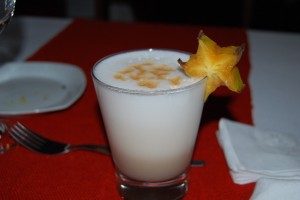
Here is the problem. Is traditional Cuzco cuisine food commonly eaten in the city that resonates with the past, or is it an innovation built on local ingredients?
I ordered the tumbo sour, as well as a sopa a la criolla, a creole soup (one of the Peruvian classics found far and wide) as well as a dish listed by many as one of the Cuzco classics, kapchi de cetas, a mushroom kapchi. Immediately the waiter, who turned out to be the owner, a young man nicely appointed in a brown business suit, informed me it was not the season for cetas, wild mushrooms.
He was right , of course. It is not, and for that reason among others I ordered the dish. I wanted to see what they would do. He said that instead of cetas they used button mushrooms, champiñones. I thanked him for his frankness and found it refreshing.
It turned out he is a lawyer by profession and only twenty-five years old. Named Patrick Pérez, he emphasizes administrative law, but is also a foodie. He grew up in Cuzco cooking with his mother and wanted to open a restaurant.
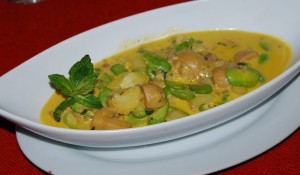
After studying in Lima, he wished to celebrate the food of his home town, particularly since he saw it was almost not represented among the restaurant offerings of Cuzco’s colonial core. He says Cuzco’s cuisine celebrates local produce and ways.
While working as an attorney he saved for the day, four months ago, when he could open his restaurant. It is his idea and his creation, even down to the photographs on the walls.
Though he works days as an attorney, he loves and finds it refreshing to come to his restaurant in the evenings to share his food with guests. Furthermore, he runs the restaurant with his fiancée, who is the chef. On Sundays, though, Patrick cooks and she staffs the front.
The tumbo sour was good, but the concentration of tumbo juice was unable to completely stand up to the sharp flavor of the pisco. Nevertheless, as a fusion kind of drink, it made a good accompaniment to the food.
The soup fit well within the standard of finely diced beef and angel hair pasta in a rich broth with a bit of milk, though I must admit I would have liked the soup to be more strongly flavored. Nonetheless on this chilly night it was very soothing and sat well on the stomach.
The kapchi was a vegetarian stew of broad beans and mushrooms in a light broth with cheese. Served with a side of slightly under-cooked rice, It had a pleasant dairy taste that did not overwhelm, but complemented the earthiness of both the fresh broad beans and the quartered mushrooms.
Though I did not try them, Chuwa also offered some intriguing novo-Andean deserts such as a quinoa mousse. I did overhear a group of up-scale American tourists comment favorably on the quinoa mousse at the same time the idea surprised them.
In sum, Chuwa was a delight, from its decor to its owner and its food, even if some details can still be improved. Its menu has food that can be called typically Cuzco cuisine, although it probably would be better described as Novo-Andean with Cuzco touches.
As Patrick noted, they serve the classic Cuzco dish chiriuchu, but instead of serving it cold they serve it hot “because that is how the tourists demand it.” Yet the very name of the dish is “cold,” (chiri.)
Chuwa shares similar transformations at the same time it contrasts with La Mila. Situated to the side of the Plaza de Regocijo, La Mila is on the second floor of one of the colonial buildings built over the channelized Saphy river. It must be entered through a handicraft market that opens off the Portal Espinar.
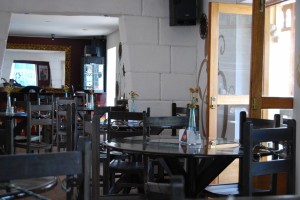
As we entered the restaurant, despite its claim to offer Cuzco cuisine, the sounds of music from Argentina’s north, with its rhythmic guitars and soulful voices, drew us in. But it was also disconcerting in a restaurant that claims to focus on Cuzco food and unlike Chuwa’s Yanni, the Argentine rhythms refused to simply become a background.
Decorated with wrought iron and painted golden curlicues on the walls, La Mila feels more like a coffee house or a bar than something specifically related to Cuzco.
The server, a very pleasant man from Córdoba, Argentina, brought us our menus and chatted with us for a bit. People often make a place. Though the conversation was enjoyable, there was no connection between the waiter and the place the restaurant claimed to represent.
A quick perusal of the menu began to explain the cultural confusion. Indeed, it mostly emphasized creole Peruvian food or more generally Latin American food with only a few Cuzco specialties on the menu, like indigenous kantu flowers in a field of foreign daisies.
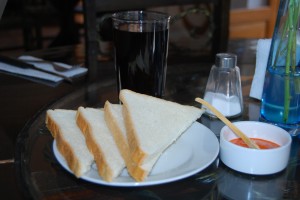
We ordered a a standard Latin American asado de lomo (pan-fried steak) and a plate containing kapchi, anticuchos (skewers), and a rocoto relleno (stuffed hot pepper), as well as chicha morada to drink. When the waiter brought our drinks he also brought a complimentary bowl of ground rocoto (local hot pepper) and a plate of white bread–pan de molde–which is like Wonderbread. Though Cuzco has amazing, award-winning artisan breads these white bread slices seemed once again to make the point of a restaurant trying to claim Cuzco food while doing little to actually substantiate the claim.
Indeed, the chicha morada tasted like it came from a package, rather than having the fulsome flavor of fruit and spices that once finds in hand made chicha moradas in Cuzco.
The kapchi was a thick lump of broad beans, mushrooms, and cheese that while bland still had some flavor. The rocoto relleno, or stuffed rocoto pepper had an undercooked and overly eggy coating as well as an under-flavored filling. It literally and figuratively paled in comparison with the stuffed rocotos sold in the streets nearby or, even better, on the plaza of the nearby city of Urcos.
The skewers were of alpaca, a meat that while popular among tourists is simply not eaten by the people of Cuzco. As a result, it can hardly be considered Cuzco cuisine even if, as in this case, it was tender, well seasoned, and tasty.
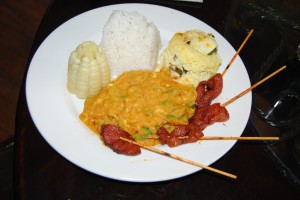
In contrast with the Cuzco food, the Latin American asado de lomo was very tender and well seasoned. It worked well and fit the Latin American code, including Cuzco. However, where it normally would have been served with rice and perhaps french fries it came with a mash of red beans, a bit like re-friend beans. They were good and worked well with the meat, but did not feel Cuzco-ish.
La Mila obviously has promise but, if it plans to continue marketing itself as a purveyor of traditional Cuzco cuisine, or an ajha wasi (chichería, or a place where once can have a glass of chicha and a plate of traditional food) then it needs to focus and define more carefully.
This issue of focus and definition is not easy, however. Cuzco’s cooking mostly still resides in its homes, street corners, and markets. It has yet to really make the pages of cook books, other than Rosario Olivas Weston’s, and has yet to be thoroughly developed by its chefs, although local culinary schools are beginning the task. Though its day is still to come, one can go to Chuwa for an upscale version of some dishes, La Mila for a wannabe take, or just eat on street corners and popular neighborhoods.
